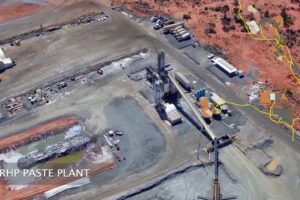OPINION Greg Smith is an international award-winning author and qualified lawyer who has spent more than two decades specialising in Employment Law and Workplace Health & Safety. Greg recently shared with Australasian Mine Safety Journal his thoughts on the industrial manslaughter debate and why he doesn’t support industrial manslaughter legislation. Greg’s view contributes to the debate on whether industrial manslaughter legislation can actually save lives across the mining industry.
Why I do not support industrial manslaughter
In a recent comment on a LinkedIn post I asked for evidence of how Industrial Manslaughter would contribute to safe workplaces. In response, I got a reply noting I had often made this observation and asking for me to explain my position.
I have written about this several times, and links to my various articles are at the bottom of this one. However, I thought readers might find it useful if I provided a summary of what I see to be the problems with both industrial manslaughter and the use of criminal prosecutions as a deterrent in workplace health and safety.
My basic concern, both with criminal prosecution generally and industrial manslaughter specifically, is they do not contribute to safer workplaces. In the case of industrial manslaughter, I am concerned it will push legal risk management to a point where it starts to compromise workplace health and safety.
Summary of Greg’s position on industrial manslaughter and safety
In summary, it is my view that:
1. The primary purpose of health and safety legislation is to create safer workplaces.
2. The primary purpose of health and safety legislation is not criminal punishment.
3. Criminal punishment is only valid in the context of health and safety legislation, to the extent that it improves health and safety outcomes.
4. There is no evidence that increasing fines and penalties for breaches of health and safety legislation improves health and safety outcomes.
5. None of the various reports arguing for the introduction of industrial manslaughter have pointed to improvements in health and safety outcomes as a reason for introducing industrial manslaughter.
6. The primary arguments for introducing industrial manslaughter are:
- Administrative convenience – we want to harmonise legislation and some jurisdictions are introducing industrial manslaughter, therefore, we had all better introduce industrial manslaughter, so we all do the same thing; and
- It is what people want – the “just deserts” theory of sentencing, whereby the punishment has to fit the public outrage about the severity of the offence (See for example Review of the model Work Health and Safety Laws – Final Report, December 2018).
7. As far I have been able to tell all the law societies, or representatives of lawyers, who have made submissions on the issue of industrial manslaughter have said it is unnecessary (See for example the Law Council of Australia submission to the Senate Education and Employment Reference Committee review into the framework surrounding the prevention, investigation and prosecution of industrial deaths in Australia, dated 30 May 2018).
8. There is evidence that increased “criminality” for breaches of occupational safety and health legislation can adversely affect health and safety outcomes. (See for example South Australian Coroner’s inquest into the death of Jorge Alberto Castillo-Riffo and Dekker., S. (2010) Pilots, Controllers and Mechanics on Trial: Cases, Concerns and Countermeasures, International Journal of Applied Aviation Studies, Volume, Number 1).
9. While I would not pretend to speak for the families of people killed in workplace accidents, when I have spoken with them they talk to me about delay, bureaucracy, a lack of information, a lack of inquiry, a lack of transparency, not understanding the process and effectively-being sidelined from the circumstances of their loved ones death (See for example: Education and Employment Reference Committee. They never came home – the framework surrounding the prevention, investigation and prosecution of industrial deaths in Australia). Industrial manslaughter is likely to increase legal complexity and legal risk management strategies (as opposed to safety risk management strategies) and exacerbate not mitigate, these concerns (See for example South Australian Coroner’s inquest into the death of Jorge Alberto Castillo-Riffo).
10. The historical evidence is clear that industrial manslaughter provisions will disproportionately be used against small business owners and small business directors (See for example Neil Foster: Personal liability of company offices for corporate Occupational Health & Safety breaches).
11. Criminal legal proceedings are unlikely to make any difference at all to company officers or executive management legal liability in larger companies, because:
- These provisions are only used against small business owners; and
- In the criminal prosecutions, the defendant (i.e. company office or company) can plead guilty and does not have to give any evidence – there is no public scrutiny of their behaviour in any real sense.
12. Prosecution significantly reduces any opportunity for learning. The cases are typically dealt with 3 – 5 years after the fatality, and they are argued on a very narrow range of facts (referred to as “particulars“), if they are argued at all. Most occupational safety and health prosecutions are dealt with by way of a guilty plea, often using an agreed statement of facts. There is no detailed analysis or discussion about the roles of different individuals, corporate culture, corporate attitude and so on.
Problems of industrial manslaughter criminal prosecution as a tool
In summary, the problems with using criminal prosecution as a tool in occupational safety and health management is:
- There is no evidence it will produce safer outcomes.
- It unfairly and disproportionately targets small business.
- It diminishes, if not completely removes, all reasonable opportunities for learning from the incident.
- It excludes the families of victims.
- It is a tool that can be used to avoid genuine executive liability.
READ RELATED ARTICLES
- Legal privilege and safety
- 20 years in prison for a mining manager
- Manslaughter legislation to extend to off-site personnel
What could an alternative look like?
Consistent with the objectives of occupational safety legislation to provide safe workplaces, an alternative model would focus on learning lessons from incidents and sharing them in a fulsome and timely manner as possible. At the same time, senior executives should be accountable to explain how their organisations allowed incidents to occur. All of this can occur with the full engagement and participation of the families of people who were killed in workplace accidents.
This model would not ignore the public’s need to see punishment for clear and egregious breaches of workplace safety, but this would not be the primary focus. Having gone through an inquiry and publication process there would still be an option to refer the matter to the relevant prosecuting authority for prosecution under new provisions in the local criminal code.
What might a genuinely different response to workplace accidents look like? And, starting with the end in mind, what could be the public response to workplace accidents that might help improve workplace safety?
While I think prosecutions and penalties have a minimal contribution to make to improving safety outcomes in workplaces, I recognise there are cases where the full weight of public outrage needs to be impressed upon recalcitrant employers and individuals. But I think we can take the prosecution and penalties out of health and safety legislation and move them into the criminal law proper.
The criminal law has shown itself perfectly capable of responding to workplace accidents, especially fatalities, and we have seen several convictions for manslaughter arising out of workplace accidents.
To my mind, the advantage of taking prosecutions and penalties out of health and safety legislation and moving them into the Criminal Codes is at least threefold.
First, it sends a message about the importance of health and safety legislation and that very serious breaches of health and safety obligations in the workplace will not be tolerated.
Second, it can free up the resources of health and safety regulators to allow them to focus on strategies of prevention and sharing lessons – to focus on improving safety not policing it.
Third, if we restrict a prosecution and penalty regime to only the most serious breaches of health and safety legislation it might help to create an atmosphere in the business community that is not scared of every little health and safety breach. It might generate a willingness to talk about health and safety more openly and honestly and share lessons and experience more readily.
But I’m not prepared to give business a free ride
Business still needs to be held accountable for workplace safety, but that accountability should be focused in a way that contributes to workplace safety.
I would propose a system whereby workplace accidents are subject to a system of independent investigation, with the scope or size of the investigation determined by the nature of the incident. Not every incident would have to trigger such investigation, but we could easily identify levels or classes of incidents that should and included discretion with the health and safety regulator to require an investigation where they think it is warranted.
These investigations would have some important characteristics:
- They would be paid for by the employer(s) involved in the incident.
- They would require an examination of senior management in the context of due diligence.
- They would have to be finalised within a mandated (short) period – months not years.
- The findings and lessons for industry would have to be published.
- The employers do not get a free ride – they have a financial accountability for the investigation, managers cannot hide behind the legal process and lessons become quickly and readily available.
There also needs to be a trade-off for this approach.
To ensure the best possible safety outcome from such an enquiry, I would propose that all the evidence in relation to the investigation is kept private as far as possible, and none of the evidence, nor the findings, nor anything arising from the investigation can be used against an employer or any other individual in any other legal proceedings whatsoever.
In addition, the investigation would have to make a finding about the level of cooperation by the various entities with the investigation, and cooperation with the investigation could be used as a mitigating factor in any subsequent criminal proceedings.
There is obviously a range of detail to be worked out in this approach, for example, we would need to include penalty provisions for not cooperating with, or misleading, the investigation.
But in my view, on balance, this type of approach provides a truly safety-focused outcome.
We would have workers compensation and other civil proceedings to compensate the victims of accidents.
We would have criminal proceedings to punish egregious breaches of health and safety.
We would have a dedicated safety process solely focused on improving safety outcomes which was not beholden to, or compromised by, any other legal process.
Or, we just keep doing what we’ve always done and hope for a different result – i.e. Industrial Manslaughter.
Greg’s article first appeared here. AMSJ have reproduced Greg’s Article on the industrial manslaughter debate with permission.
Do you have some thoughts on industrial manslaughter legislation in the mining industry? We’d love to hear from you. You can either post a comment below or email our team at miningeditor@aprs.com.au
Read more Mining Safety News














Add Comment